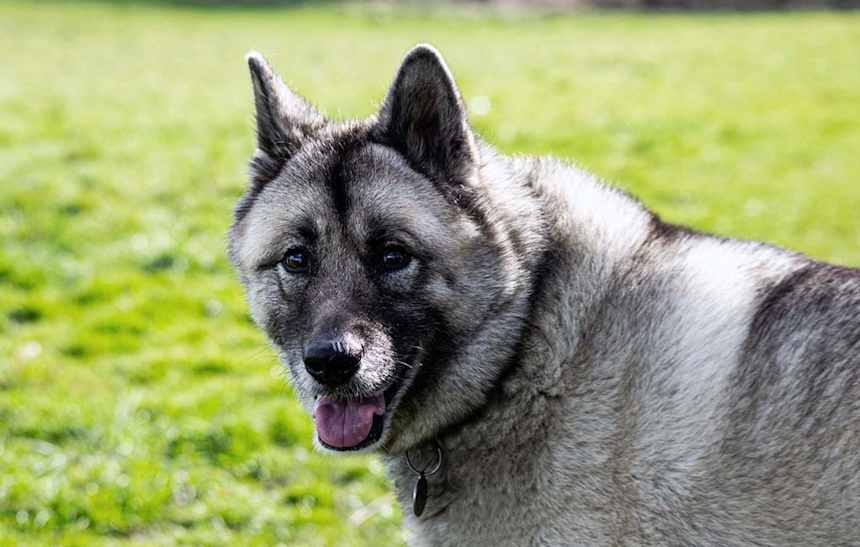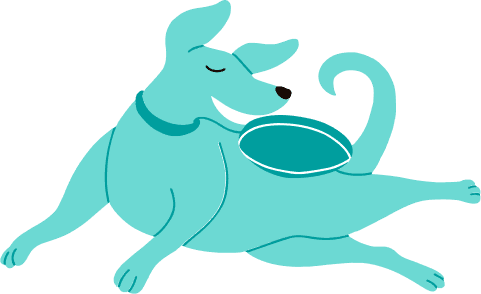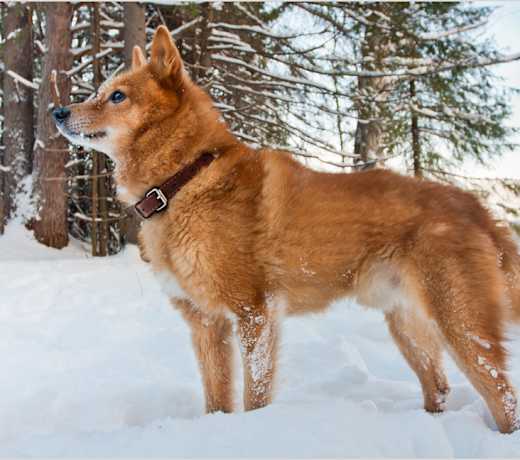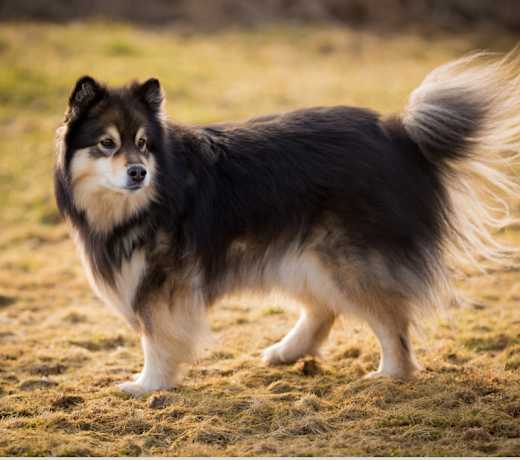A Norwegian Elkhound will reach their full size at around 12 months old. However, they may continue to fill out and gain muscle for another year or so.
Norwegian Elkhound
Breed Type: Hound
Common nicknames: Norwegian Moose Dog, Gray Norwegian Elkhound
Coat: Double
Hypoallergenic: No, they will likely trigger allergies.
Temperament: Friendly, loyal, energetic, smart
Life expectancy: 12-15 years
Color & patterns: Gray

The spirited Norwegian Elkhound is like a furry little Viking on a mission to conquer your heart. As part of the Spitz Northern breed group, Norwegian Elkhounds share a lineage with other bold and independent canines such as the Malamute, Akita, and Husky. With their medium size and thick, luxurious coats, these spunky companions are always ready for an adventure. Norwegian Elkhounds are intelligent and tenacious, making them excellent hunters and devoted family members. Their alert and friendly natures also make them great companions for active individuals and families. So, if you’re seeking a reliable and spunky pup, the Norwegian Elkhound is the perfect choice for you.
Norwegian Elkhound characteristics
Learn about about Norwegian Elkhound basics like their fur colors, shedding levels, how much grooming they need, and other Norwegian Elkhound facts.
Average height
18-21 inches (45.7-53.3cm)
Average weight
35-70 pounds (15.9-31.8 kg)
Average lifespan
12-15 years
Exercise needs
Grooming needs
Full-grown size
Good with cats
Good with kids
Training Aptitude
What colors do Norwegian Elkhounds come in?
Norwegian Elkhounds are varying shades of gray. They are referred to as the “Gray Moose Dog” in Norway. The most common color is gray, ranging from light silver to dark steel gray, followed by black with a mix of gray. A less common color is red or a reddish-brown shade. All colors are typically accompanied by a lighter undercoat, and the breed’s double coat gives them a distinctive, well-insulated appearance.
How big do Norwegian Elkhounds get?
Norwegian Elkhounds are large dogs, most weighing between 48 and 55 pounds and standing around 19.5 to 20.5 inches tall.
Do Norwegian Elkhounds shed?
Yes, Norwegian Elkhounds shed quite a bit. They have a double coat, which consists of a dense undercoat and a longer, coarser outer coat. This combination helps them withstand cold weather but also means they shed heavily, especially during seasonal changes. Norwegian Elkhounds will blow their coat twice a year, at which time you may notice an increase in shedding. Grooming a Norwegian Elkhound is pretty straightforward: regular brushing helps keep their coat healthy and smooth, while mitigating shedding.
Norwegian Elkhound temperament
Learn about about the Norwegian Elkhound temperament and how well they fit into your lifestyle, home environment, and family.
Are Norwegian Elkhounds good with kids?
Yes, Norwegian Elkhounds are generally good with children. They have a friendly and playful nature, which makes them suitable family pets. Their energetic and spirited personality often resonates well with kids, and they tend to enjoy interactive play and activities.
Norwegian Elkhounds are typically patient and tolerant, but their enthusiasm and energy can sometimes be a bit much for very young children.
As with any breed, it is recommended that your child is always supervised when interacting with your Norwegian Elkhound to keep both the child and dog safe. Teaching children how to properly approach and handle dogs is crucial to ensure positive experiences for both the dog and the child, as is teaching dogs how to interact gently with children.
Are Norwegian Elkhounds good with cats?
Norwegian Elkhounds were bred to hunt, so you will probably find them giving chase to your cat. Of course, each dog (and cat) has their own preferences and temperament, but you can feel fairly confident your Norwegian Elkhound, if properly socialized to your cat and/or introduced at a young age, should get along well.
Are Norwegian Elkhounds good with other dogs?
Yes, Norwegian Elkhounds generally get along well with other dogs, but their interactions can vary based on individual temperament and early socialization. Norwegian Elkhounds are energetic and playful, which can make them good companions for other dogs, especially those who have similar energy levels. They have a strong prey drive due to their history as hunting dogs, which might lead them to chase or show high excitement around smaller or more timid dogs. Some Norwegian Elkhounds may exhibit dominant or assertive behavior, which can lead to conflicts with other dogs if not managed properly.
As with any breed, individual personalities play a significant role. While many Norwegian Elkhounds are sociable and get along well with other dogs, there can be exceptions based on their unique temperaments.
Do Norwegian Elkhounds bark a lot?
Yes, Norwegian Elkhounds are quite vocal. Norwegian Elkhounds have been bred for thousands of years as a hunting dog, and their method of hunting involves locating and cornering their prey by baying and barking so their pet parent can find them. As such, they do have a tendency to use their voices quite a bit.
Their barking can also be attributed to their high energy levels and their need for mental stimulation. If not given enough to do, they might bark more out of boredom or frustration.
While their barking can be managed with proper training and sufficient exercise, it’s important to be prepared for a breed who enjoys expressing itself vocally. As with any dog, they can be discouraged from barking as frequently with proper training and exercise.
Are Norwegian Elkhounds good family dogs?
Yes, Norwegian Elkhounds can make excellent family dogs. They are known for their friendly, loyal, and energetic nature, which can be a great fit for active families. The Norwegian Elkhound is a beloved companion in its native Norway and is slowly gaining popularity stateside.
Norwegian Elkhounds are independent yet devoted, intelligent, and energetic, so an active family that will give this breed the exercise it needs is the best match. The Norwegian Elkhound is smart, can learn commands and tricky quickly, and can adapt to different living environments as long as they get regular exercise.
Are Norwegian Elkhounds easy to train?
Training a Norwegian Elkhound can be challenging but with a confident, experienced trainer, you can be sure you’ll have a well-behaved family companion. Norwegian Elkhounds are intelligent but extremely independent, as most of the more ancient breeds are. This independence can sometimes make them less eager to please compared to more submissive breeds. Training may require a bit more patience and consistency to overcome their occasional stubbornness.
Early socialization is important to ensure they grow up to be well-adjusted and responsive to training, and their high energy levels mean they need regular mental and physical stimulation. Your Norwegian Elkhound will likely require a training approach that balances structure with plenty of positive reinforcement to keep them motivated and responsive.
However, keep in mind that training any dog takes substantial time and effort, regardless of breed.
Are Norwegian Elkhounds smart?
Yes, Norwegian Elkhounds are smart dogs. They are known for their intelligence and ability to learn commands and tasks quickly. Their intelligence is often coupled with a strong work ethic and problem-solving skills, which were essential for their original roles as hunting and guarding dogs. These dogs can figure out puzzles and are great at adapting to new situations. To keep them happy and well-behaved, they need regular mental stimulation and challenges. Boredom can lead to undesirable behaviors, so providing them with interactive toys and engaging activities is important.
Are Norwegian Elkhounds friendly?
Yes, Norwegian Elkhounds are friendly dogs known for their affectionate and loyal nature. They form strong bonds with family members and tend to get along well with people. They are playful and fun and usually good with children. Early socialization and training contribute significantly to their friendly behavior. Proper exposure to different people, animals, and environments helps them develop a well-rounded and approachable personality.
Are Norwegian Elkhounds high maintenance?
Norwegian Elkhounds are considered to be moderate in terms of maintenance. They require regular grooming to prevent matting and to keep their coat in good condition. Their dense fur needs attention to avoid buildup of dirt and debris. Norwegian Elklhounds are active dogs who need regular exercise to stay healthy and happy, as well as mental stimulation so they don’t get bored. With proper care and attention, they are well-suited to active families who can meet their needs.
Do Norwegian Elkhounds cuddle?
Yes, Norwegian Elkhounds can be affectionate and enjoy cuddling with their families. They are loyal and loving, which often includes seeking out physical closeness and comfort from their pet parents. They may seek out a cozy spot to rest and often enjoy snuggling on a couch or bed with their pet parents, especially after playtime or exercise. They enjoy both active play and quiet moments of affection. If you’re looking for a dog who enjoys physical closeness, a Norwegian Elkhound is likely to fit that role well.
Norwegian Elkhound history
Learn about where the Norwegian Elkhound came from.
Is a Norwegian Elkhound part wolf?
The Norwegian Elkhound evolved partially from an ancestral gray wolf species found in central Europe and western Russia, which is why they resemble wolves. The breed is part of the Spitz family, which also includes breeds like the Siberian Husky and Alaskan Malamute. The Elkhound is among Europe’s oldest dogs and has been bred for specific traits like hunting and guarding rather than wolf-life characteristics.
Where are Norwegian Elkhounds from?
Norwegian Elkhounds hail from – you guessed it – Norway. The breed standard may have only been written in the late 1800s, but fossils have confirmed that this type of hunting spitz dog goes all the way back to the Stone Age. There are several types of Scandinavian Elkhounds, among which the Norwegian Elkhound is the most popular. As part of the Spitz Northern breed group, Norwegian Elkhounds share a lineage with other bold and independent canines such as the Malamute, Akita, and Husky. With their medium size and thick, luxurious coats, these spunky companions are always ready for an adventure.
How long do Norwegian Elkhounds live?
A healthy Norwegian Elkhound will live between 12 and 15 years. Like all breeds, their longevity can be influenced by factors such as genetics, diet, exercise, and overall health care. Regular veterinary check-ups, a balanced diet, and an active lifestyle can contribute to a longer and healthier life for your Norwegian Elkhound.
Are Norwegian Elkhounds rare in the U.S.?
Norwegian Elkhounds are relatively uncommon in the U.S. compared to more popular breeds, but they are not extremely rare. They are a distinctive breed with a unique appearance and a rich history, and they have a dedicated following among enthusiasts. Networking with breed clubs or attending dog shows could be good ways to connect with the breed community and find a dog.
Norwegian Elkhound health
Learn about about the Norwegian Elkhound health outlook and what diseases they may be prone to at various stages of their life.
Do Norwegian Elkhounds have health issues?
Overall, the Norwegian Elkhound is a robust and healthy breed. Diseases to watch out for include:
Hip and/or elbow dysplasia: Hip and elbow dysplasia are two of the most common skeletal diseases seen in dogs. They are similar diseases in which either the hip or elbow joint has grown abnormally or is misshapen. The abnormal shape prevents the joints and sockets from adequately meeting one another, resulting in rubbing and grinding instead of sliding smoothly. Though the main complication with hip dysplasia is joint instability, the abnormalities present in elbow dysplasia often result in pieces of bone and/or cartilage breaking loose and irritating the joint tissues. Over time, the rubbing from dysplasia can cause a variety of issues, such as pain, lameness, and secondary osteoarthritis. Surgery can be done to fix the joint if diagnosed before the onset of arthritis. If you are rescuing a Norwegian Elkhound, have them checked out by a vet to see if they have or are prone to getting dysplasia, so you know what they will be able to handle regarding activities and exercise.
Eye issues: Cataracts, a common eye condition that causes cloudiness in the eye and obstructs vision; and progressive retinal atrophy (PRA), a progressive degenerative disease affecting the retina that eventually leads to blindness.
Others: Renal issues, cysts, and obesity are other concerns. Your vet may want to do joint and imaging tests.
Are Norwegian Elkhounds hypoallergenic?
No, Norwegian Elkhounds are not hypoallergenic. They have a double coat, which consists of a dense undercoat and a longer, coarser outer coat. This combination helps them withstand cold weather but also means they shed heavily, especially during seasonal changes.
Popular Norwegian Elkhound mixes
Characteristics of a Norwegian Elkhound mix can vary widely depending on the specific breeds involved, the individual dog’s genetics, and its upbringing. A few common Norwegian Elkhound mixes include:
Miniature Pinschelkhound (Norwegian Elkhound + Miniature Pinscher)
Elk-Kee (Norwegian Elkhound + Keeshond)

Find Norwegian Elkhound puppies near you
Adopting a Norwegian Elkhound
Learn about acquiring a Norwegian Elkhound - the pros and cons of adopting versus going through a breeder, and associated costs.

Gus/Courtesy Post
Norwegian Elkhound Terrier (Unknown Type, Medium)
Male, 10 yrs 3 mos
Long Beach, CA

Gus/Courtesy Post
Norwegian Elkhound Terrier (Unknown Type, Medium)
Male, 10 yrs 3 mos
Long Beach, CA



